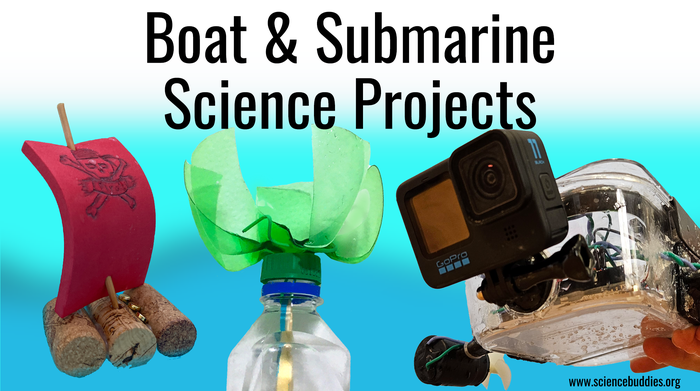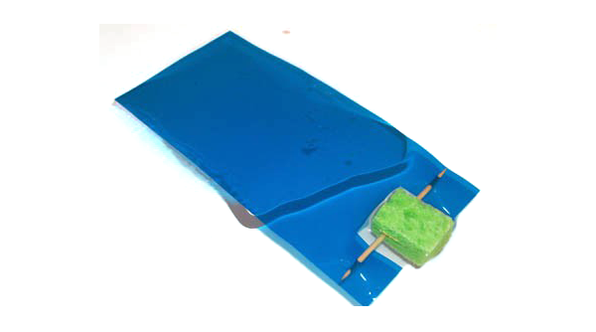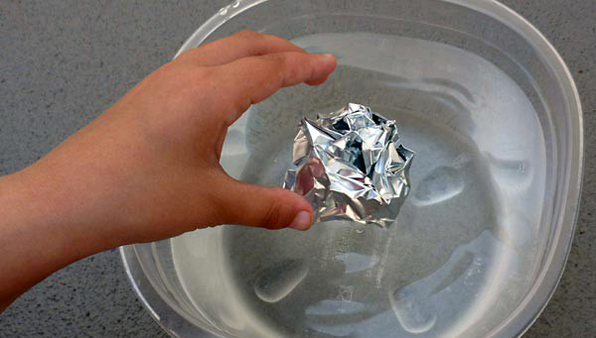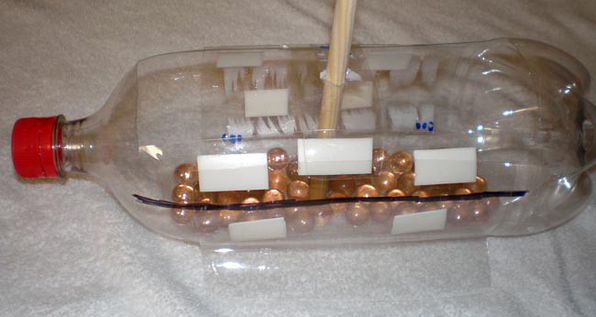13 Boat and Submarine Science Projects and Experiments
Investigate the physics of boat design, floating, sinking, and more with boat and boat design science and engineering projects, including DIY sailboats, submarines, and underwater ROVs.

Boat and Submarine Science Experiments
For students fascinated with boats, submarines, and other water vehicles, science projects can make great hands-on explorations. These projects can be fun in summer months or for a school science project or the science fair. With plenty of room for kids to experiment with boat design prototyping, testing, and iteration, these STEM projects encourage innovative and creative thinking, use the engineering design process, and put physics concepts into motion (or afloat). Students can experiment with boats, submarines, and other water vehicles, including remote-controlled ones, in a bathtub, a tub of water, or a small wading pool for outdoor fun!
Experiment with the design and operation of boats, submarines, and other underwater vehicles to learn more about the physics of how these vehicles float and move. Projects include experiments to explore hydrodynamics, density, buoyancy, forces, and more with simple boats and models, including DIY sailboats, rubber band-powered paddle boats, plastic bottle submarines, and underwater vehicles that use Arduino.
The science and engineering projects below have been grouped into the following categories:
At the bottom of this resource, you will find a list of additional independent student science and science fair projects, related lesson plans and STEM careers, and a list of key vocabulary words to know when exploring boat and submarine science.
Boat Science Projects
1. Sailboat Science
In the Capsized! How Sailboats Stay Upright project, students experiment with homemade cork sailboats to find out how sailboats stay upright. As part of the experiment, students investigate the role of the keel and the ballast and determine how the necessary ballast weight relates to the height of the sailboat. Question: What is the relationship between the ballast and a boat's center of mass? The Make a Toy Sailboat activity can also be used for an informal experiment using DIY cork sailboats. As part of the activity, students make boats of different sizes (with different numbers of corks) and observe how the boat's balance changes.
2. DIY Paddle Boats
In the Make the Fastest Rubber Band Paddle Boat project, students design and build rubber band paddle boats and use different materials to see which will make the fastest boat. Samples are shown (in videos) for boats made from balsa wood, cardboard covered in duct tape, and popsicle sticks. Part of the experiment is to find a way to minimize drag and get the biggest push from the paddle. Changing the design of the boat, including its shape, is one approach. Changing the materials used in the boat is another. Question: How might adding a rudder improve the movement of the boat? See also the Build a Rubber Band Paddle Boat activity.
3. How Do Heavy Boats Float
In the How Much Weight Can Your Boat Float? project, students investigate the physics of boat design that make it possible for boats made from heavy materials (like steel) or boats carrying heavy loads to float. What keeps them from sinking? Using boats made from aluminum foil, students explore the relationship between the shape of a boat and how much it can carry without sinking. Question: What does the density of water have to do with the design of a boat? See also the How Much Weight Can Aluminum Foil Boats Float? activity.
4. Surface Tension Movement
In the Build a Raft Powered by Surface Tension project, students use simple rafts made from transparencies, sponges, and toothpicks to explore surface tension. Questions: Can you use the surface tension of the water to make the boat move? What role does dish soap play in this experiment? See also the Build a Bathtub Toy Raft Powered by Surface Tension activity for a similar experiment using surface tension.

5. Milk Carton Boats
In the Milk Does Your Body and a Boat Good—Design Your Own Milk Carton Boat project, students assemble different kinds of model boats constructed from milk cartons. Design examples include a raft, a catamaran, and a V-shaped hull. Once the model boats are built, students test key features, such as stability, maneuverability, and how well each boat glides. Question: Which type of hull will be the most stable?
6. Archimedes' Principle and Floating
In the Archimedes Squeeze: At What Diameter Does an Aluminum Boat Sink? project, students explore Archimedes' Principle using aluminum foil "boats" (spheres of aluminum foil) that have the same mass but different diameters and different density. Starting with the largest boat, students will progressively make the boat smaller (increasing the density) to discover at what point the boat will sink. Students will observe how density relates to how much water each boat displaces and how this relates to whether a boat floats or sinks. Question: What creates the upward buoyant force when a boat is placed in water?

7. Stay Steady with a Bilge Keel
In the Rocking the Boat project, students learn how bilge keels are used to minimize how much boats roll side to side. Using a model boat made from a plastic bottle, students design and test bilge keels in different shapes and sizes. Question: What kind of force does a bilge keel create that helps stop the rolling motion of a boat?

8. A Boat's Hull
In the Making It Shipshape: Hull Design and Hydrodynamics project, students explore how the hull of a boat helps reduce drag in the water and experiment by testing different hull designs using model wooden boats. Question: Which hull shape most reduces the drag force in the water?
9. Radio-controlled Boat
In the Build an RC Boat project, students build a radio-controlled (RC) boat. This project is similar to the Underwater ROV (below), but the RC boat is untethered and maneuvered by a handheld control that transmits instructions to an onboard receiver. Question: What other functionality could be added to the RC boat to increase its usefulness?
Submarines and Other Underwater Vehicle Science Projects
10. Submarine Buoyancy
In the Bottled-up Buoyancy project, students make a submarine from recycled soda bottles and experiment to see how buoyancy is related to how a submarine dives and surfaces. Question: How does a submarine change its buoyancy?
11. Submarine Fins
In the Do Submarines Need Fins? project, students build a miniature submarine from recycled soda bottles and test different types and placement of stabilizing fins to find the best combination of stability and forward motion. Question: What would happen to a submarine if it didn't have stabilizing fins?
12. Underwater ROV
Remotely operated vehicles (ROVs) can be helpful in dangerous situations or to reach locations that are inaccessible to humans. In the Build a Remotely Operated Vehicle (ROV) for Underwater Exploration project, students build a waterproof ROV and control and maneuver it using Arduino. The underwater ROV has two motors, which means it can only steer left and right. Question: Since the ROV can't be driven up or down, how can you control its buoyancy? For a simplified underwater robotics project that doesn't require programming, see Build a Simple Underwater Robot.
Educator Lesson Plan
13. Aluminum Foil Boat Design: Surviving the Stormy Seas
The Aluminum Foil Boat Design: Surviving the Stormy Seas lesson expands on the classic "aluminum foil boat" project. Moving beyond seeing how much weight aluminum foil boats can hold before sinking, students experiment to see how well the boats do in waves.
Additional Boat Science Projects for Students Doing Independent Science Projects or Science Fair
Related STEM Careers
As students get hands-on with boat design and submarine science, they can learn more about related STEM career paths with career profiles like:
Vocabulary
The following word bank contains words that may be covered when researching or teaching about boat and submarine science.
- Archimedes' principle
- Autonomous underwater vehicles (AUV)
- Balance
- Ballast
- Buoyancy
- Buoyant force
- Capsizing
- Center of Mass
- Density
- Drag
- Forces
- Gravity
- Hull
- Keel
- Kinetic energy
- Mass
- Newton's third law of motion
- Paddle boat
- Potential energy
- Radio-controlled (RC) robots
- Remotely operated vehicles (ROV)
- Stabilizing fins
- Weight
Thematic Collections
Collections like this help educators find themed activities in a specific subject area or discover activities and lessons that meet a curriculum need. We hope these collections make it convenient for teachers to browse related lessons and activities. For other collections, see the Teaching Science Units and Thematic Collections lists. We encourage you to browse the complete STEM Activities for Kids and Lesson Plans areas, too. Filters are available to help you narrow your search.
Note: Science Buddies Lesson Plans contain materials to support educators leading hands-on STEM learning with students. Lesson Plans offer NGSS alignment, contain background materials to boost teacher confidence, even in areas that may be new to them, and include supplemental resources like worksheets, videos, discussion questions, and assessment materials. Activities are simplified explorations that can be used in or out of the classroom. Student projects support students conducting independent science projects.
Categories:
You Might Also Enjoy These Related Posts:
- Teach Genetics and Heredity with Free STEM Lessons & Activities - Genetics Science Projects
- Star Wars Projects for May the 4th Be With You Science
- 25+ Earth Day Science Experiments and Activities
- Arduino Science Projects and Physical Computing
- Spring Science Projects: 26 Science Experiments for Spring
- 25+ Robotics Projects, Lessons, and Activities
- March Madness Basketball Science Projects: Sports Science Experiments
- 15 Density Science Experiments
















